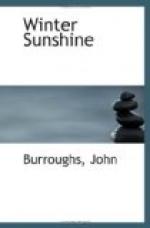But with March our interest in these phases of animal life, which winter has so emphasized and brought out, begins to decline. Vague rumors are afloat in the air of a great and coming change. We are eager for Winter to be gone, since he, too, is fugitive and cannot keep his place. Invisible hands deface his icy statuary; his chisel has lost its cunning. The drifts, so pure and exquisite, are now earth-stained and weather-worn,—the flutes and scallops, and fine, firm lines, all gone; and what was a grace and an ornament to the hills is now a disfiguration. Like worn and unwashed linen appear the remains of that spotless robe with which he clothed the world as his bride.
But he will not abdicate without a struggle. Day after day he rallies his scattered forces, and night after night pitches his white tents on the hills, and would fain regain his lost ground; but the young prince in every encounter prevails. Slowly and reluctantly the gray old hero retreats up the mountain, till finally the south rain comes in earnest, and in a night he is dead.
IV. THE FOX
I have already spoken of the fox at some length, but it will take a chapter by itself to do half justice to his portrait.
He furnishes, perhaps, the only instance that can be cited of a fur-bearing animal that not only holds its own, but that actually increases in the face of the means that are used for its extermination. The beaver, for instance, was gone before the earliest settlers could get a sight of him; and even the mink and marten are now only rarely seen, or not seen at all, in places where they were once abundant.




